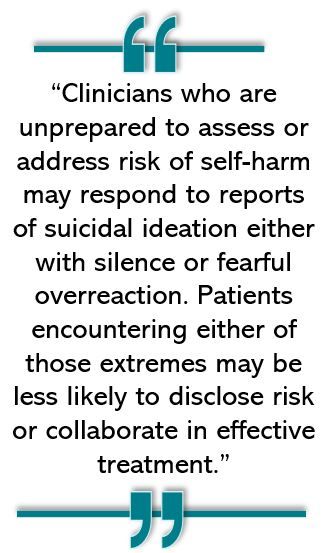USPSTF: Screen Adults for Depression, Anxiety, Suicide Risk in Primary Care
Primary care physicians should screen adult patients for depression and anxiety disorders, according to the US Preventive Services Task Force (USPSTF).
On June 20, USPSTF published the new recommendation statements in hopes of increasing treatment and reducing the effects of major depressive disorder (MDD) and anxiety disorders. In primary care, screening for both should happen for asymptomatic adults aged 19 years and older, including pregnant and postpartum people. Adults aged 65 years and older should be screened for depression, but evidence is inconclusive about benefits of screening older adults for suicide risk and anxiety, according to USPSTF.
Screening is a first step toward treatment, the task force said.
©Billion Photos/Adobe Stock

“To achieve the benefit of depression screening and reduce disparities in depression-associated morbidity, it is important that persons who screen positive are evaluated further for diagnosis and, if appropriate, are provided or referred for evidence-based care,” the authors wrote. Likewise for anxiety disorders, according to that separate recommendation.
The task force cited figures that show the scope of MDD in patients in the United States:
- In 2019, 19.4 million adults experienced at least one major depressive episode.
- That year, 13.1 million adults had at least one major depressive episode with severe impairment.
- Self-reported depression during pregnancy rose from 11.6% of patients in 2016 to 14.8% in 2019.
JAMA also published the USPSTF recommendation and accompanying editorials and patient pages about primary care evaluations for depression and anxiety disorders.
Suicide risks?
USPSTF said there was insufficient evidence to assess the balance of benefits and harms of screening for suicide risk in the adult population. That finding “will likely meet objections,” said Gregory Simon, MD, MPH, Julie E. Richards, PhD, MPH, and Ursula Whiteside, PhD, authors of the JAMA editorial “Reframing the Key Questions Regarding Screening for Suicide Risk.”

They noted physician response will be a key to reducing subsequent suicidal behavior, not just reducing suicidal ideation.
“Clinicians who are unprepared to assess or address risk of self-harm may respond to reports of suicidal ideation either with silence or fearful overreaction,” the authors said. “Patients encountering either of those extremes may be less likely to disclose risk or collaborate in effective treatment.”
Physicians should avoid responses that are “stigmatizing, coercive, or even dangerous,” such as “welfare checks” by armed law enforcement officers. Those responses can be especially dangerous for people in racial and ethnic minority communities, the authors said.
The task force shared figures about the scope of suicide in the United States:
- Suicide is the 10th leading cause of death for adults, with 45 390 in 2019.
- From 2001 to 2017, there was a 31% increase in suicide deaths, although the total declined 3% from 2019 to 2020.
- Suicide is the second-leading cause of death in people aged 10 to 34 years.
- Among individuals who die by suicide, 83% were seen in primary care in the previous year, and 24% had mental health diagnoses in their medical records in the month prior to death.
There was limited evidence about harms of screening for suicide. USPSTF noted potential harms include false positive screenings that lead to unnecessary referrals and treatment, which take time and money, and labeling, anxiety, and stigma.
Anxiety disorders
USPSTF recommended physicians screen adult patients aged 64 years or younger for anxiety disorders. There was insufficient evidence to assess potential benefits and harms of screening for anxiety disorders in adults aged 65 years and older. Treatments could include psychotherapy, pharmacotherapy, and relaxation and desensitization therapies.
There are a number of “anxiety disorders” that can be seen in adults, and physicians must do additional evaluation to determine the level of anxiety and need for treatment or referrals, said Murray Stein, MD, MPH, and Linda L. Hill, MD, MPH. They penned the JAMA editorial “Are There Reasons to Fear Anxiety Screening?”
Some conditions will involve physical health or lifestyle problems “that (sit) squarely in the wheelhouse of the primary care clinician,” the authors said.
Some conditions will involve physical health or lifestyle problems “that (sit) squarely in the wheelhouse of the primary care clinician.”
“Clinicians screening for anxiety in the primary care setting should be prepared to rule out these possible causes of anxiety before referring to a mental health practitioners, particularly if that mental health practitioner does not have medical training,” the editorial said.
The authors used the examples of thyroid disease or excessive caffeine consumption. Some anxiety will be post-traumatic stress disorder – something USPSTF missed a chance to highlight, according to the editorialists.
Primary care physicians and other clinicians may need additional training to be comfortable diagnosing anxiety disorders, but the results can be life-altering or lifesaving for patients, Stein and Hill said.
Sources
US Preventive Services Task Force issues final recommendation statements on screening for anxiety disorders, depression, and suicide risk in adults. News release. US Preventive Services Task Force. June 20, 2023. Accessed June 21, 2023.
US Preventive Services Task Force. Screening for depression and suicide risk in adults: US Preventive Services Task Force Recommendation Statement. JAMA. 2023;329:2057-2067. doi:10.1001/jama.2023.9297
JAMA Editorial: Reframing the Key Questions Regarding Screening for Suicide Risk
JAMA Editorial: Suicidality Screening Guidelines Highlight the Need for Intervention Studies
Podcast: Arthritis, Anxiety, and Depression: Managing a Common Comorbidity
May 14th 2012Anxiety is even more common than depression among people who have arthritis, a new study has shown. Here to discuss the implications for diagnosis and treatment is Eilzabeth Lin MD, a family medicine physician who is a longstanding researcher in the field of depression and pain.